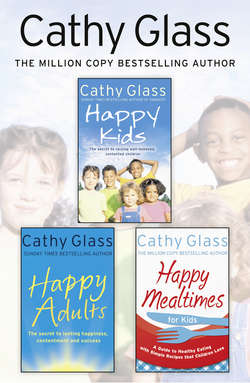Читать книгу Cathy Glass 3-Book Self-Help Collection - Cathy Glass, Cathy Glass - Страница 34
It’s the behaviour that’s wrong
ОглавлениеWhen disciplining your child for bad behaviour, always remember that it is the behaviour that is wrong, and not the child. Never say, ‘Tom, you are a naughty/bad/selfish/hurtful boy to do that.’ Tom will feel that he is, and is more likely to repeat the negative behaviour. Do say, ‘Tom, that was a naughty/bad/selfish/hurtful thing to do.’ Then add some explanation as to why the behaviour was wrong, setting it in a general context. ‘Tom, it was naughty to pull Claire’s hair because it hurts. Don’t do it again, please. Good boy.’ Or ‘Claire, it’s wrong to snatch Tom’s sweets. Ask him nicely if you can have one. Good girl.’ This separates the child’s bad behaviour from the child, who is intrinsically good and wants to do the right thing. No child is inherently bad, and all children want to do what is right, although it may not always seem like it at the time.
Don’t assume the child knows why the behaviour was wrong or what is correct behaviour. Add a simple statement of why the act was wrong – ‘Because it hurts’ – and what is correct – ‘Ask Tom if you can have one of his sweets.’ And always add the praise – ‘Good boy/girl', as praise creates the positive assumption that the child deserves it, and will not be repeating the negative behaviour in the future.
When I foster children who have come from highly dysfunctional families where there were no rules and no respect, I have to go back to basics, whatever the child’s age, and teach them what behaviour is acceptable and what is not. Initially, if the child is completely out of control, I have to put in place the basic rules of no hitting, biting, kicking, etc. very quickly, using the 3Rs. When the child has calmed down a little, having been reassured that I have his or her behaviour under control, he or she becomes more receptive, and will often ask why he shouldn’t do something. The child isn’t being cheeky or insolent; he or she genuinely doesn’t know. Children who have been raised in functioning and loving families with clear boundaries will have been brought up with guidelines for acceptable behaviour and by the time they start school will know what is right and wrong, and why. But if a child has spent all of his or her life in a feral existence where everyone looked after number one, to the exclusion of everyone else, this will not be obvious; they won’t know what is acceptable behaviour. Past experience will have taught the child that he had better take care of his own needs as no one else will, and if he wants something, he will take it by fighting if necessary.
Simply telling a child from this type of background that biting hurts and that we don’t like it being done to us, so we don’t do it to others, is often news to the child. But no matter how dreadful the child’s behaviour is when they first arrive (and I’ve seen some pretty awful behaviour), I know that beneath all the anger, swearing and aggression is a loving, gentle child who desperately wants to do the right thing so that they can fit in and be loved.
The length of time it takes to socialise the child and modify his unacceptable behaviour depends on how violent and abusive their family background, and how old the child is when he or she comes into care. The longer he or she has been in a dysfunctional environment, the longer it takes. But even a teenager can be turned around with clear consistent boundaries, rewards and sanctions, using the 3Rs. They eventually come to see that it is not they, the person, who is bad, but the way they behave, which is a product of their experience, and which they have control over and can change.
